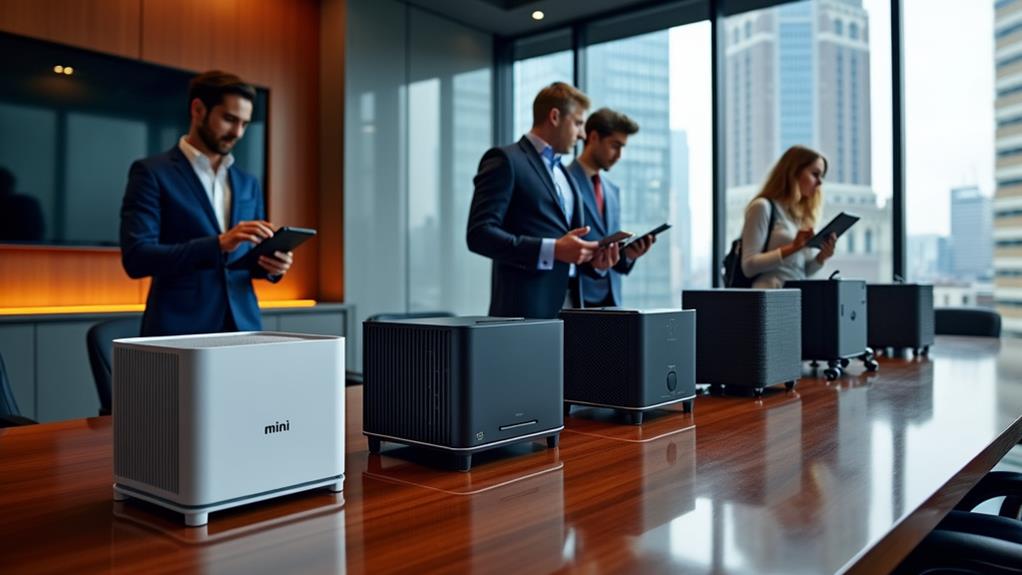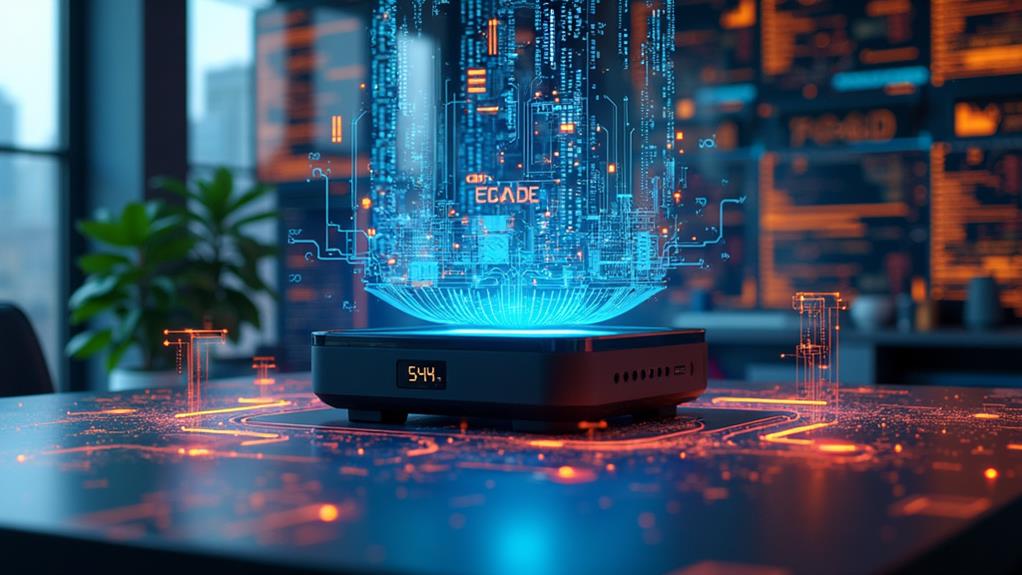



You've probably wondered whether mini PCs can serve as thin clients in enterprise environments. Do they succeed in providing the same functionality and efficiency? The answer isn't a straightforward yes or no. Mini PCs bring more processing power and flexibility to the table compared to traditional thin clients, but this added muscle comes with the weight of additional infrastructure and management overhead. This trade-off raises intriguing questions about the suitability of mini PCs as thin clients in your workplace. What specific needs will they fulfill, and where will they fall short?
Key Takeaways
- Mini PCs can be managed by centralized systems like Intune, making them suitable for some thin client-like functionalities.
- Resource-intensive tasks, like multimedia editing, require the stronger processors and more powerful hardware found in mini PCs.
- Mini PCs can operate independently and provide offline computing capabilities, unlike traditional thin clients.
- Mini PCs can run full-fledged operating systems and install custom software, offering more flexibility and functionality.
- The cost and complexity analysis of mini PCs in enterprise environments must consider both deployment and infrastructure costs.
Differences in Computing Concepts
Mini PCs and thin clients fundamentally differ in their computing concepts, with mini PCs intrinsically serving as fully capable computers, while thin clients rely heavily on remote servers for both processing and data storage. This difference affects how they are used and configured.
As self-contained computing devices, mini PCs excel in handling resource-intensive tasks and can perform a wide range of desktop functions, whereas thin clients are primarily designed for simple and lightweight tasks. Their reliance on servers means they are better suited for Virtual Desktop Infrastructure (VDI) and remote access applications.
Thin clients typically have fewer local resources and require robust network connectivity to operate effectively. This limits their aptitude to handle complex tasks, making them more suitable for controlled environments where central management is emphasized. In contrast, mini PCs offer greater autonomy and can be used independently for tasks like graphic design, video editing, and gaming.
Thus, understanding these fundamental differences is essential to making informed decisions about whether mini PCs can be used as thin clients in enterprise environments, depending on specific computing requirements and IT infrastructure needs.
Key Features and Capabilities
Key features and capabilities of mini PCs that facilitate their use as thin clients in enterprise environments include enhanced processing power, flexible storage options, and the ability to connect to remote desktop infrastructure. These attributes make mini PCs an attractive alternative for organizations seeking to harmonize their computing infrastructure.
For instance, mini PCs can run full operating systems, allowing for the installation of custom software and offering more versatility compared to traditional thin clients. Their compact size and lightweight computing capabilities make them ideal for dense deployments or remote work setups.
Moreover, mini PCs can leverage centralized management systems like Intune, ensuring seamless integration into Virtual Desktop Infrastructure (VDI). This enables organizations to balance the benefits of centralized management with the autonomy of local processing. When considering thin clients for enterprise environments, the unique features and capabilities of mini PCs should not be overlooked.
Performance for Resource-Intensive Tasks
You need to weigh the processing power and storage capacity of mini PCs if you plan to utilize them for resource-intensive tasks in an enterprise environment. Mini PCs boast stronger processors and more powerful hardware than thin clients, making them suitable for handling multimedia editing, graphic design, and video editing. These tasks require significant computing resources, which thin clients cannot provide. While thin clients are designed to offload most processing tasks to the server, mini PCs can operate independently, offering a more robust computing experience for users who need higher performance.
In resource-intensive scenarios, mini PCs excel due to their powerful hardware. For example, applications like graphic design and video editing demand substantial processing power, which mini PCs can provide. This makes them a viable alternative to traditional desktop computers. Without the need to rely on a server infrastructure for processing tasks, mini PCs offer faster and more responsive performance for users. By leveraging these key features, mini PCs can handle demanding computing tasks efficiently, enhancing productivity in enterprise environments.
Deployment and Infrastructure Costs
While mini PCs offer substantial processing power for resource-intensive tasks, their deployment and infrastructure costs in an enterprise environment require careful consideration, including server infrastructure, software licensing, and IT management overhead.
- Server Infrastructure Cost: Mini PCs are capable of handling more tasks, meaning less server infrastructure is needed, which can lead to long-term cost savings.
- Software Licensing: Mini PCs may require per-device licenses, which differ from thin clients that leverage server-based licensing, so the costs and complexities of these licenses must be weighed.
- IT Management Overhead: Mini PCs necessitate managing individual devices, increasing the support overhead compared to thin clients, which are typically managed centrally.
Functionality and Flexibility
In contrast to traditional thin clients, mini PCs offer substantially enhanced functionality and flexibility due to their ability to handle more resource-intensive applications and provide local storage and offline computing capabilities. This means you can use mini PCs in various roles, such as digital signage or for remote work, without relying on a constant connection to a remote server.
Mini PCs can run full-fledged operating systems and install custom software, expanding their capabilities beyond remote desktop access. This versatility makes it easier for enterprises to tailor computing experiences to user needs, whereas traditional thin clients are more limited in their configurations. For instance, if you need to run locally stored programs or support multiple high-resolution monitors, mini PCs are better suited. Additionally, their higher processing power and local storage make them more robust against network connectivity issues. With respect to desktop infrastructure, mini PCs offer much-needed flexibility, making them an attractive option for enterprises looking to move away from traditional thin clients.
Use Case Scenarios and Suitability
Identifying the right computing solutions for specific use cases within an enterprise is essential to leveraging the benefits of mini PCs as thin clients effectively. To determine the suitability of mini PCs as thin clients, you must consider the unique requirements of different scenarios.
For specific situations, mini PCs offer advantages over traditional thin clients. Here are some key use cases:
- Branch Offices: Mini PCs can serve as reliable, self-contained computing solutions for distributed teams, reducing dependence on network connectivity.
- Content Creation: Mini PCs offer enhanced processing capabilities, making them well-suited for video editing, 3D modeling, and other resource-intensive tasks.
- Remote Work: Mini PCs provide a local processing power that offsets the risk of data breaches and lag in virtual desktop environments.
- Small Operations: Integrating mini PCs into a Desktop Infrastructure (VDI) offers a hybrid approach, combining local processing with centralized management and security benefits.
Frequently Asked Questions
Is a Mini-Pc a Thin Client?
"No, a mini PC isn't a thin client. Despite advanced hardware and performance capabilities, storage options, and portability, mini PCs are self-contained systems focused on local processing and storage, unlike thin clients which rely on remote servers for these tasks."
What Are the Three Types of Thin Clients?
You will encounter three types of thin clients: terminal server-based, cloud-based, and zero clients. Each has distinct network infrastructure requirements, user authentication methods, and data storage solutions that impact your software deployment and management.
What Is the Difference Between a Thin Client and a Thin Pc?
As you choose between thin clients and mini PCs, consider your performance requirements, hardware specifications, software compatibility, network connectivity, data storage, security measures, remote management, and user experience.
What Are Mini PCS Used For?
Imagine a palm-sized powerhouse seamlessly handling low power computing tasks. Mini PCs serve as portable workstations, offering energy efficiency, remote desktop access, cloud computing integration, and multi-tasking capabilities in a space-saving design that operates silently and efficiently for office productivity at budget-friendly prices.
Conclusion
In selecting between mini PCs and thin clients, consider the trade-offs. While mini PCs offer enhanced functionality, they require more infrastructure and management. Thin clients provide simplified management but lack computing power. Determine which option best fits your needs, based on performance requirements, deployment costs, and IT support. Make your choice wisely, as it will be a "go" or "no-go" decision for your enterprise.
Disclosure: As an Amazon Associate, I earn from qualifying purchases.




